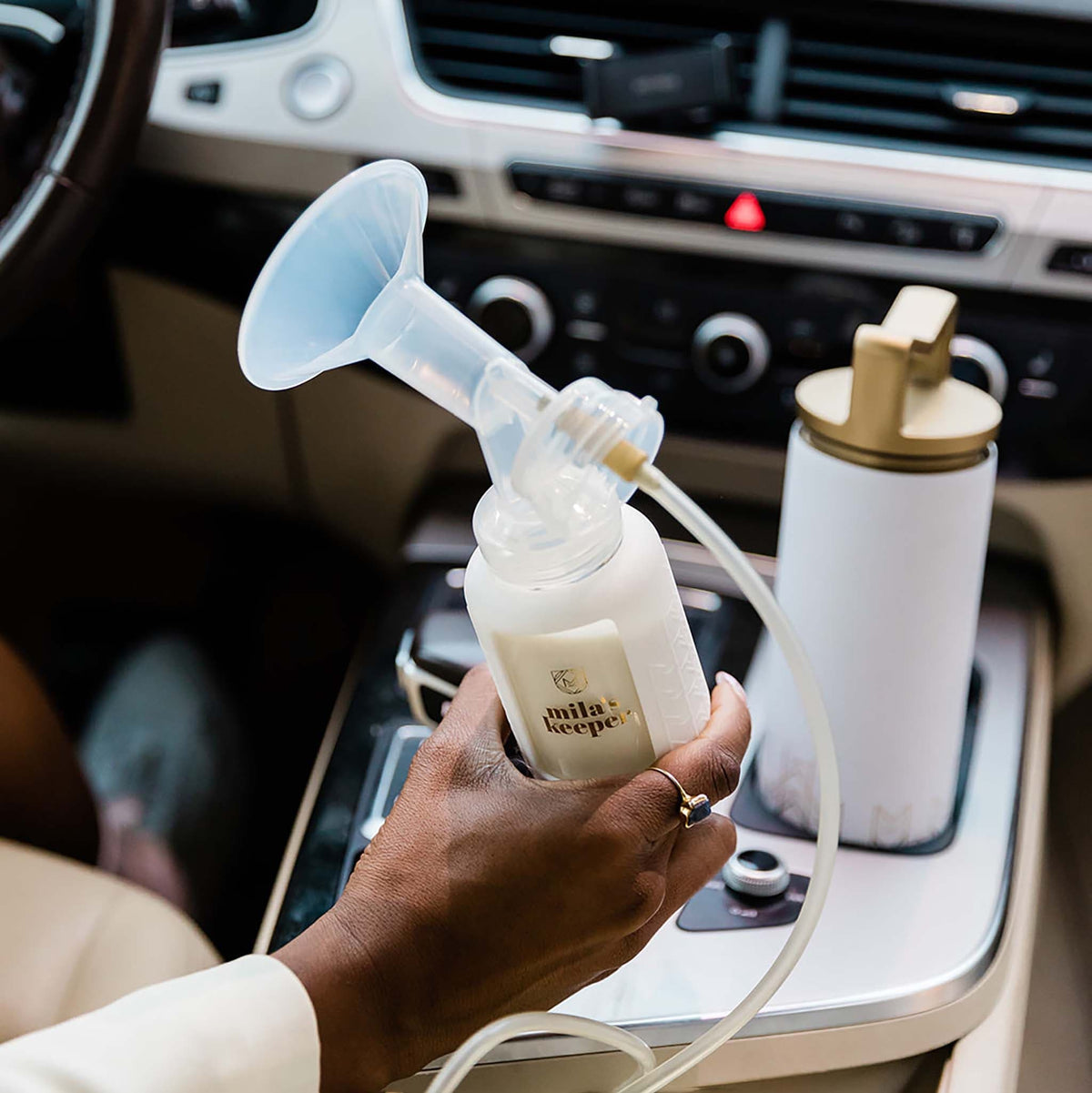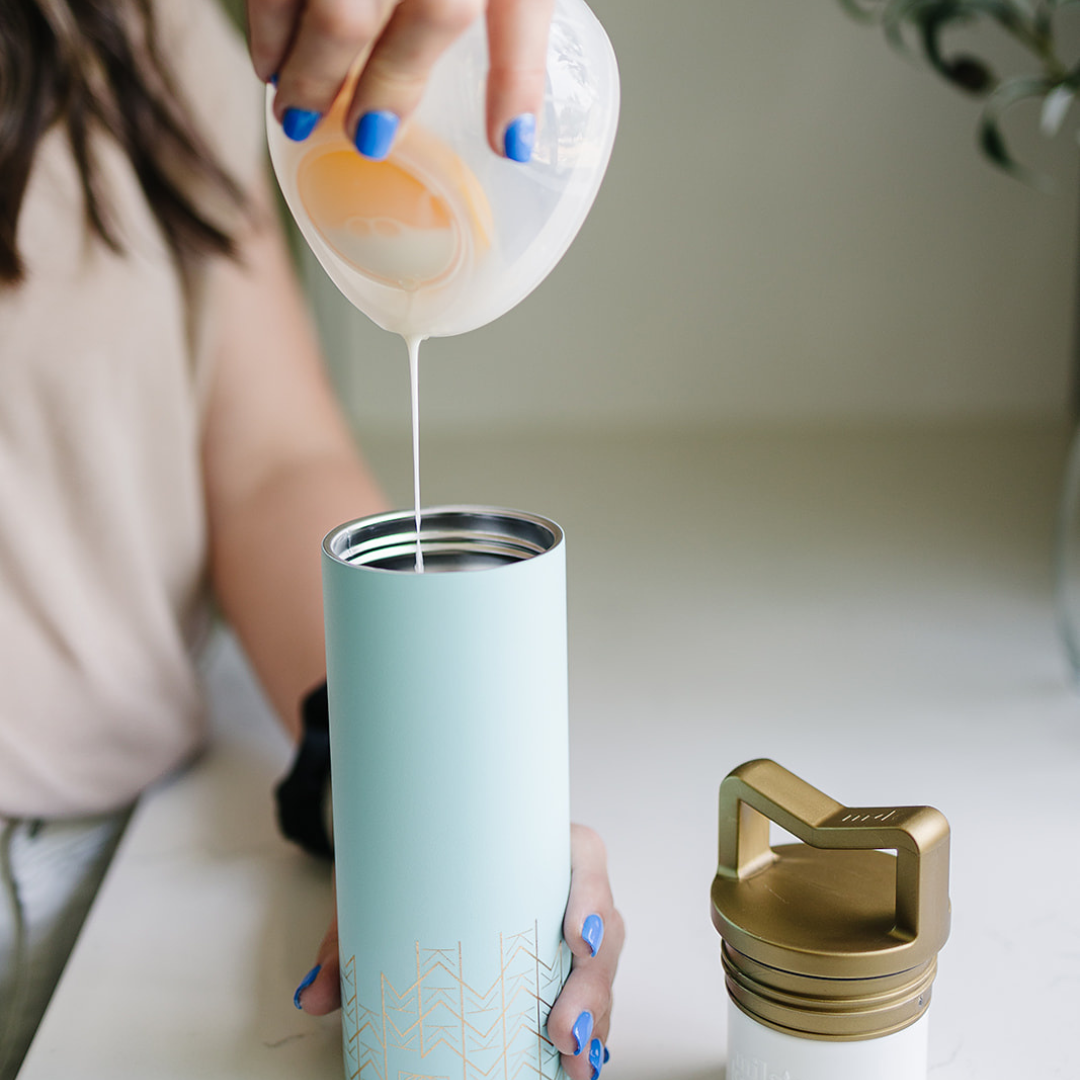With the average length of maternity leave being 12 weeks in the U.S., and with the CDC recommending that babies be breastfed exclusively for the first 6 months of life, and continue to receive breast milk for up to 2 years of age, many nursing mamas will find themselves pumping upon returning to work. A good amount of those mamas will want to continue to breastfeed their babies when they can, adapting a nursing/pumping hybrid routine.
Breastfeeding and pumping aren’t just for working mamas though. Combining breastfeeding and pumping can be a great way to provide breast milk for your baby while also maintaining your milk supply and having the flexibility to have others feed your baby when needed.
Read on for our tips and tricks on combining breastfeeding and pumping. Just remember, every mother and baby is unique, and what works for one may not work for another. Be patient with yourself and your baby as you navigate this process. With time and practice, you’ll find a routine that works best for you and your little one.

How to Combine Breastfeeding and Pumping
Is combining breastfeeding and pumping possible?
Yes, combining breastfeeding and pumping is absolutely possible and commonly done by many mamas. It can be an effective way to provide breast milk to your baby while also allowing for flexibility and convenience. By combining the two, you can breastfeed your baby directly when you’re together and use pumped milk for feedings when you’re apart or when someone else needs to feed your baby. If you're wondering can you combine breast milk from different breasts? Or can you mix breast milk from different pumping sessions? Yes, to those as well.
When done correctly and consistently, combining breastfeeding and pumping can help you establish a good milk supply and ensure that your baby receives the benefits of breast milk.
Some moms may find it easier to combine breastfeeding and pumping, while others may face challenges. It may take time to find a routine and balance that works best for you and your baby.
Challenges of combining breastfeeding and pumping:
Breastfeeding and pumping can come with various challenges. Here are some of the common difficulties that mamas may encounter:
Some women may struggle with low milk supply or difficulty in establishing sufficient milk production. This can make it challenging to produce enough milk both for breastfeeding and pumping sessions and frustrating to spend so much time and effort attempting to do so.
Both breastfeeding and pumping require a significant time commitment. It can be difficult to find the time for frequent breastfeeding sessions and pumping sessions throughout the day, especially for mamas with older kids or who are working outside the home.
Finding the right balance between breastfeeding and pumping sessions can be tricky. If pumping sessions are too frequent or prolonged, it may affect the time and energy available for breastfeeding and bonding with your baby.
Every woman is different, and while some women may find themselves to be super-pumpers, churning out an endless supply of breast milk, other women may find it challenging to get an adequate amount of milk while pumping. This can be hugely discouraging, making it difficult to continue for as long as they’d hoped.
Breastfeeding and pumping can sometimes lead to emotional challenges. Mamas can experience a variety of feelings, from guilt, pressure, or frustration if they’re unable to breastfeed exclusively or pump enough milk.
Managing pumped milk, including storage, labeling, and transportation, can be a logistical challenge. For those pumping at work, maybe adopting the pitcher method could make the process more manageable.

Importance of Establishing a Breastfeeding and Pumping Schedule
Establishing a regular schedule for both breastfeeding and pumping can help to stimulate and maintain your milk supply. Consistency is key when it comes to breastfeeding and pumping, as regular and frequent milk removal signals your body to produce an adequate amount of milk.
Having a schedule can help establish a predictable feeding routine for both you and your baby. This can be especially beneficial if you’re also introducing bottle feeding with pumped milk. A schedule allows you to plan your day and helps your baby develop a sense of routine and stability, and also helps you to balance breastfeeding with pumping sessions.
Having a schedule also allows you to plan your day more effectively. You can schedule your pumping sessions around other activities, such as work, appointments, or outings, ensuring that you have dedicated time for breastfeeding and pumping.
A schedule can also help you keep track of your milk production. By noting the amount of milk you pump during each session, you can monitor your milk supply and make adjustments if needed. This can be particularly useful if you’re concerned about a low milk supply or trying to increase your production.
Remember that while a schedule can provide structure and organization, it’s important to remain flexible and responsive to your baby’s needs. Babies’ feeding patterns change and evolve, and they may require more or less frequent feedings at different stages of development. Being attuned to your baby’s cues and adjusting the schedule accordingly is essential for successful breastfeeding and pumping.
Creating a Pumping and Breastfeeding Schedule
According to La Leche League, a good schedule for a breastfeeding and pumping mom who works an 8-hour day would be to nurse her child before going to work, pump mid-morning, at lunchtime, and then mid-afternoon. She could then nurse her baby upon returning home.
Of course, a pumping and breastfeeding schedule can vary depending on factors such as your baby’s age, your milk supply, and your specific circumstances.
Generally, newborn babies will need to eat every 1-3 hours, with that changing to every 2-4 hours over the next few weeks and months. There isn’t a hard and fast schedule that you should follow, it’s more important to follow your baby’s cues and adapt the schedule to their individual needs.
Below is a chart that shows how many ounces of breast milk your baby will need based on their weight. Remember, these guidelines are general and individual needs will vary.
5 lbs 12 oz
6 lbs 14 oz
7 lbs 17 oz
8 lbs 19 oz
9 lbs 22 oz
10 lbs 24 oz
11 lbs 26 oz
12 lbs 29 oz
13 lbs 31 oz
14 lbs 34 oz
How to determine the right frequency and duration of pumping sessions
In the early stages, especially for newborns, it’s recommended to pump or breastfeed on demand. This means paying attention to your baby’s hunger cues and offering a feeding whenever they show signs of hunger, such as rooting, sucking motions, or increased alertness. Pumping sessions can be scheduled to align with these demand feedings, which is especially helpful for working mamas who plan to solely breastfeed on the weekends.
Also in the early stages, when establishing your milk supply, it can be helpful to pump more frequently. Aim for at least 8-12 pumping sessions per day if you’re exclusively pumping. More frequent pumping helps stimulate production and establishes a good milk supply.
If your baby is exclusively breastfeeding, try to mimic their feeding patterns when scheduling pumping sessions. For example, if your baby typically feeds every 2-3 hours during the day, you can aim to pump every 2-3 hours as well. This helps maintain a similar frequency and ensures regular milk removal.
Make sure you’re paying attention to your milk production during pumping sessions. If you notice that you’re consistently getting enough milk to meet your baby’s needs and maintain your supply, you can gradually reduce the frequency of pumping sessions. Or, if you’re interested in putting your surplus supply to good use, look into donating your extra milk. On the other hand, if you’re not producing enough milk, you may need to increase the frequency or duration of your pumping sessions.

Pumping After Breastfeeding
How long should you wait after breastfeeding before pumping?
The optimal time to wait after breastfeeding before pumping can vary from person to person. However, a general recommendation is to wait at least 30-60 minutes after breastfeeding before pumping. Waiting 30-60 minutes between breastfeeding and pumping sessions helps ensure that you have a sufficient milk supply for both breastfeeding and pumping. It also allows your body time to produce more milk before the next pumping session.
Keep in mind that the timing may also depend on your individual circumstances and goals. If you’re exclusively breastfeeding and have a plentiful milk supply, you may choose to wait longer between breastfeeding and pumping sessions. On the other hand, if you’re exclusively pumping or have concerns about low milk supply, you may opt for shorter intervals between breastfeeding and pumping to maintain consistent milk production.
How to increase milk supply through pumping after breastfeeding
If you’re looking to increase your milk supply through pumping after breastfeeding, try pumping directly after breastfeeding your baby. Once your baby has had enough, continue to pump for an additional 10-15 minutes on each breast. The extra pumping session stimulates further milk production and helps signal your body to produce more milk.
Another thing to try is power pumping. Power pumping is when you pump in a specific pattern to mimic a baby’s cluster feeding. A typical power pumping session involves pumping for 20 minutes, resting for 10 minutes, pumping for 10 minutes, resting for 10 minutes, and finally pumping for another 10 minutes. We know that sounds like a lot, but aim to power pump once or twice a day for a few days to boost the milk supply.
Another tried and true method is to increase the frequency of your pumping sessions. Adding an extra pumping session or two throughout the day, in addition to your regular breastfeeding sessions, can provide more stimulation for your breasts and help increase milk production.
Double pumping is another way to increase milk supply. Double pumping involves the use of a double electric breast pump to pump both breasts simultaneously. Double pumping is more efficient and can help stimulate a higher milk production response compared to pumping one breast at a time. It can also be a great way to cut back on the amount of time you spend pumping.
Storing and Thawing Breast Milk
If you plan to pump your breast milk, it’s essential to know how to properly store it.
First off, you want to make sure that you’re using BPA-free containers, like our breast milk storage containers, that are specifically designed for storing breast milk.
You’ll want to be sure to always label and date each container of breast milk. That way, you’ll be sure to use the oldest milk first to maintain proper rotation.
If expressed milk isn’t going to be used within 4 hours, it will need to be refrigerated. Freshly expressed breast milk can be stored in the refrigerator for up to 4 days. If it hasn’t been used after 4 days, you’ll want to get it in the freezer, where it can stay for 6-12 months.
Thawing breast milk
Remember the motto: First in, first out. You always want to thaw the oldest breast milk first. You’ll want to thaw your breast milk either in the refrigerator overnight, in a container of warm or lukewarm water, or under lukewarm running water.
If you’re thawing breast milk in the refrigerator, you need to use it up 24 hours from the point it’s thawed out. You’ll need to use breast milk within 2 hours once it’s been brought to room temperature or warmed. Another important rule: Never refreeze breast milk after it has thawed.

Maintaining Milk Supply While Working
Tips for maintaining milk supply while working outside of the home
Maintaining milk supply while working outside of the home can be challenging, but with some planning and strategies, it’s definitely possible.
Set a regular pumping schedule that aligns with your baby’s feeding patterns. Aim to pump every 3-4 hours, or as close as possible, to mimic the frequency of your baby’s nursing sessions.
Choose a high-quality electric breast pump that suits your needs. A hands-free or double pump is great for more efficient milk removal while multitasking. Look into what your insurance covers and what is eligible to be purchased with FSA/HSA funds.
Talk to your employer or HR department about a private space for pumping, if there isn’t already a designated area. Be sure to look into what should be provided in the state you live in, so you know exactly what to ask for.
If you get the chance, start pumping and storing breast milk a few weeks before returning to work. Getting a head start on building up a freezer stash will take some stress off you when it’s time to get back in the office.

Involving Your Partner in the Breastfeeding and Pumping Process
Involving your partner in supporting your breastfeeding and pumping journey can be beneficial for you, your partner, and your baby.
Have an open and honest conversation with your partner about your needs and expectations. Clearly communicate your breastfeeding and pumping goals, challenges you may face, and the support you require. Listen to your partner’s perspective and find ways to work together.
Define roles and responsibilities that can be shared between you and your partner. This may include household chores, baby care tasks, meal preparation, or other daily responsibilities.
Encourage your partner to learn about breastfeeding and pumping. Attend breastfeeding classes together, read books or articles, and discuss the benefits of breastfeeding with them.
Make sure that they know how to properly handle and store breast milk so that you both feel comfortable with them taking on the task themselves.
Breastfeeding and pumping can take up a significant amount of time and energy. Your partner can help by taking on household chores, such as cooking, cleaning, laundry, or grocery shopping. This allows you to focus on breastfeeding and pumping without additional stress.
Your partner can also assist in taking care of the baby’s needs beyond breastfeeding. They can handle diaper changes, burping the baby, or getting them down to sleep.
While breastfeeding is something only a mama can do, you can have your partner help out with nighttime feedings if you factor that into your breast milk supply. If you’re pumping, having your partner take on one of the nighttime feedings will allow you to get a little more of the sleep you probably desperately need.
Recognize that flexibility is important when caring for a newborn. Be willing to adapt the division of responsibilities as needed. Support each other when unexpected situations arise and find solutions together.
Involving your partner in your breastfeeding and pumping journey is a team effort. Open communication, mutual understanding, and shared responsibilities can make the experience more fulfilling for both of you.
Safely Store Breast Milk Anywhere with Mila's Keeper!
We know that so many of you amazing mamas out there are busy making your mark on the world while raising little ones. We’re always looking for ways to make what you’re doing easier, and our hope is that our products will help you busy mamas be able to pump and store breast milk easily while on the go!
Keep Reading related blog: 7 Things to Consider When Preparing to Return to Work While Breastfeeding
--
A female-designed and female-run company, Mila's Keeper is on a mission to empower women to thrive during their breastfeeding journey by offering reusable, eco-friendly breast milk storage solutions for their day-to-day needs. Get the latest tips and info on Mila's Keeper products by following us on Facebook, Twitter, Instagram, Pinterest, and LinkedIn.























